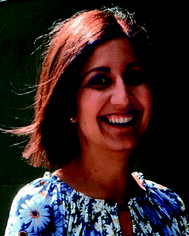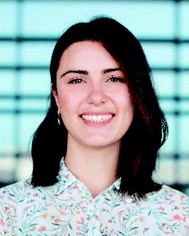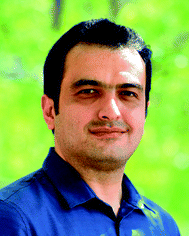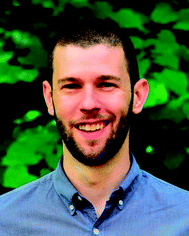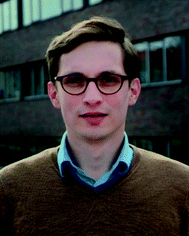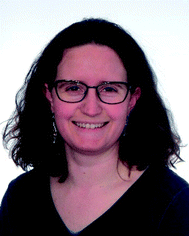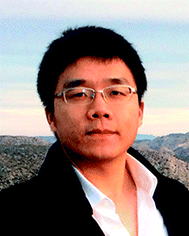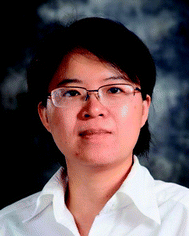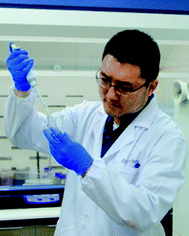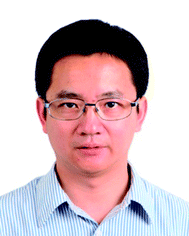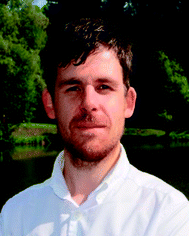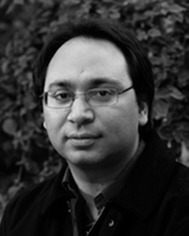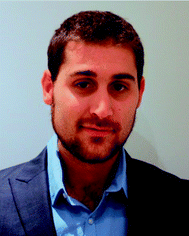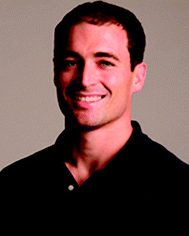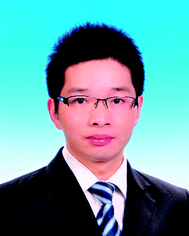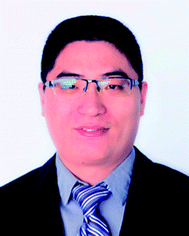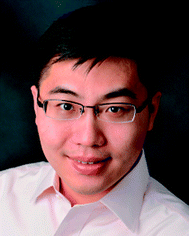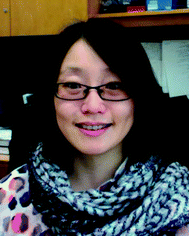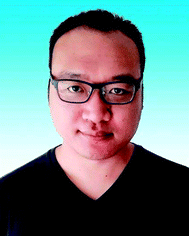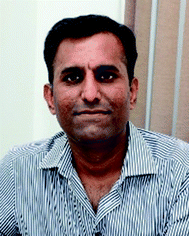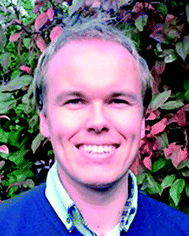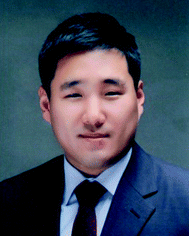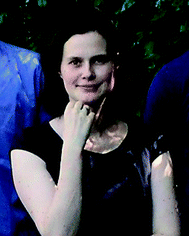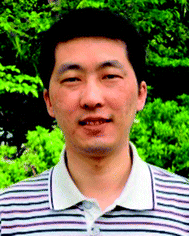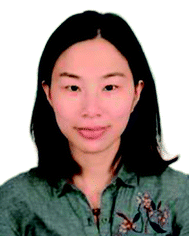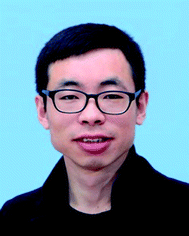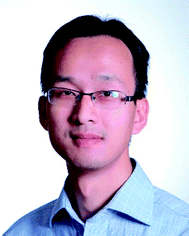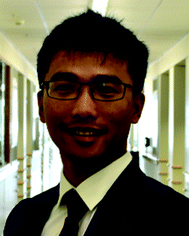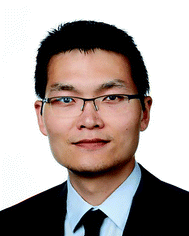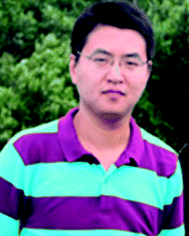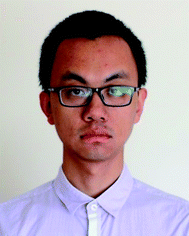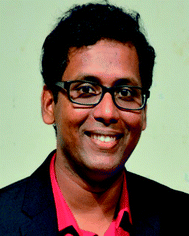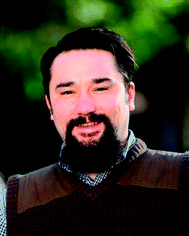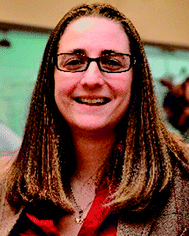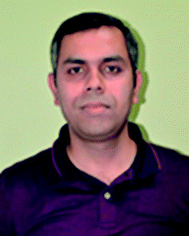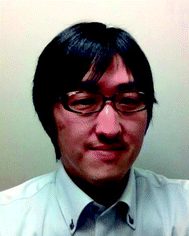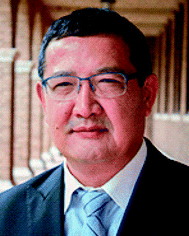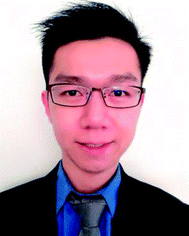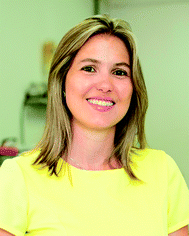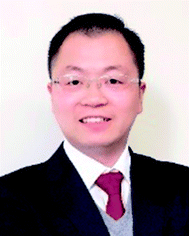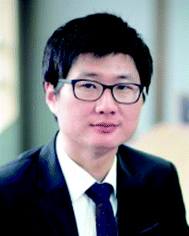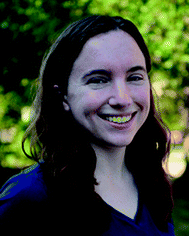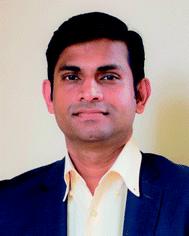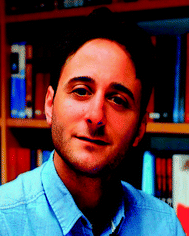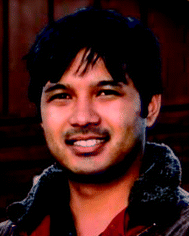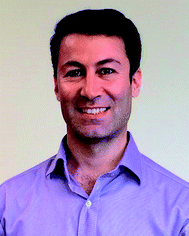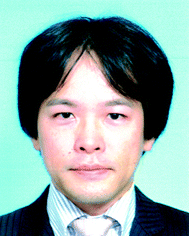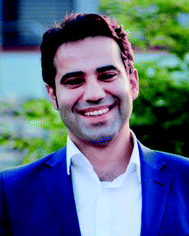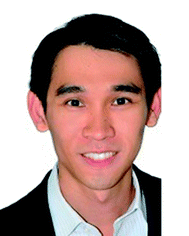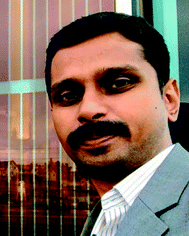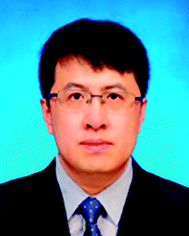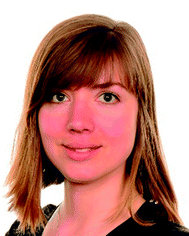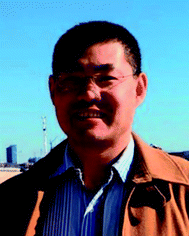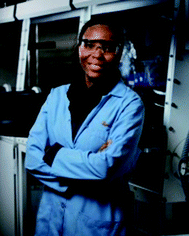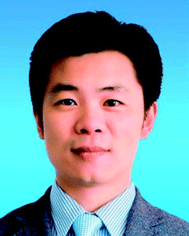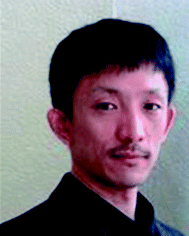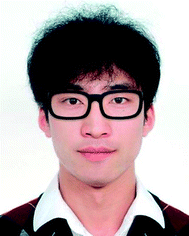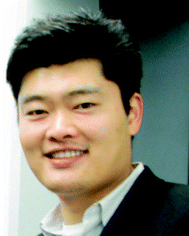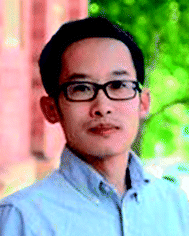DOI:
10.1039/C8TA90238K
(Profile)
J. Mater. Chem. A, 2018,
6, 21641-21653
Journal of Materials Chemistry A profiles: Contributors to the Emerging Investigators 2018 issue
Abstract
Our 2018 Emerging Investigators themed issues gather some of the best research being conducted by scientists in the early stages of their independent career. Each contributor was recommended as carrying out work with the potential to influence future directions in materials chemistry. Congratulations to all of the researchers featured, we hope you enjoy reading this issue.
Dr Veronica Augustyn is an Assistant Professor of Materials Science & Engineering at North Carolina State University. She received her B.Sc. in Materials Science & Engineering from the University of Arizona, her Ph.D. from University of California, Los Angeles working with Prof. Bruce Dunn (2013), and was a Postdoctoral Fellow at the Texas Materials Institute at the University of Texas at Austin with Prof. Arumugam Manthiram (2013–2015). Her research is focused on the synthesis and characterization of materials operating at electrochemical interfaces. In particular, she is interested in the relationships between material composition, structure, and morphology and the resulting electrochemical mechanisms. In addition to her research, she leads an international outreach project at NC State, SciBridge, which develops renewable energy research and education collaborations between universities in east Africa and the U.S. She is the recipient of a 2017 NSF CAREER Award and a 2016 Ralph E. Powe Jr Faculty Enhancement Award, and is a 2017 Scialog Fellow in Advanced Energy Storage from the Research Corporation for Science Advancement.
Dr Natalie Banerji is a Full Professor of Physical Chemistry at the University of Bern. She studies organic and hybrid materials using ultrafast spectroscopy, in view of solar cell and bioelectronic applications. In 2016, she was awarded an ERC Starting Grant. She studied Chemistry at the University of Geneva and obtained her Ph.D. in 2009 (with Prof. E. Vauthey). She then moved to the University of California Santa Barbara during a post-doctoral stay with Nobel Laureate Prof. A. J. Heeger. In 2011, she started her independent career at the Ecole Polytechnique Fédérale de Lausanne (EPFL) with an Ambizione Fellowship by the Swiss National Science Foundation (SNSF). She obtained an SNSF-Professorship at the University of Fribourg in 2014 and was nominated tenured Associate Professor in 2015.
Dr Derya Baran lived in four different countries including Turkey (her mother land), where she received her B.Sc. and M.Sc. degrees at METU. She did her Ph.D. in Germany and received a Helmholtz Postdoctoral Fellowship in 2015 for postdoctoral studies as a joint research associate at Imperial College London and Research Center Jülich. Since 2017, she is an assistant professor of Material Science and Engineering at King Abdullah University of Science and Technology (KAUST). Her motivation for research is driven by curiosity and her research group focuses on engineering smart materials for electricity-generating devices such as photovoltaics and thermoelectrics.
Dr Majid Beidaghi is an Assistant Professor of Materials Engineering at the Department of Mechanical Engineering at Auburn University. He obtained his Ph.D. in Materials Engineering from Florida International University in 2012. Then, he joined the A. J. Drexel Nanomaterials Institute and the Department of Materials Science and Engineering at Drexel University to work as a Postdoctoral Research Associate in Prof. Yury Gogotsi’s group from 2012 to 2015. He received the Ralph E. Powe Junior Faculty Enhancement award in 2017. The current research in Beidaghi’s research group focuses on the synthesis of advanced materials and development of manufacturing methods for applications such as energy storage (batteries and supercapacitors), sensors, and separation membranes.
Dr Christopher Bejger is studying the design, synthesis, and assembly of molecular clusters for energy applications. He is originally from Buffalo, NY and received his B.S. from the University of Oregon in 2006. He obtained his Ph.D. in chemistry from the University of Texas in 2012 under the direction of Professor Jonathan Sessler studying redox-active tetrathiafulvalene macrocycles. He was a Seaborg Graduate Fellow at Los Alamos National Laboratory in 2011. He joined the group of Professor Colin Nuckolls at Columbia University in 2013 as a Camille and Henry Dreyfus Environmental Chemistry Postdoctoral Fellow. His postdoctoral research focused on the synthesis of metal chalcogenide cluster-based solid-state materials. Christopher started his independent research career at the University of North Carolina at Charlotte as an Assistant Professor of Chemistry in 2015.
Dr Lars Borchardt is a chemist. He received his Ph.D. in inorganic chemistry at Technische Universität Dresden (Germany) in 2013. Afterwards, he went to ETH Zürich (Switzerland) for postdoctoral studies and returned to TU Dresden in 2014 with his own junior research group. He is inspired by alternative and counter-intuitive synthesis concepts. Currently he uses the mechanical forces of colliding balls in planetary ball mills to construct porous carbons and polymer frameworks.
Dr Ute Cappel is an Assistant Professor in the Division of Applied Physical Chemistry at KTH-Royal Institute of Technology. She obtained her Ph.D. degree in Chemistry in 2011 from Uppsala University on solid state dye-sensitized solar cells. Following this, she was a postdoc at Monash University and then received a Marie Curie fellowship to investigate hybrid solar cells at Imperial College London. Ute returned to Sweden in 2014 as a postdoc and then researcher at Uppsala University. She recently started her tenure-track position at KTH, where her research focusses on using time-resolved photoelectron spectroscopy for the characterisation of solar cell materials.
Dr Qi Chen received both his B.S. and M.S. degrees at Tsinghua University, and received his Ph.D. degree at University of California, Los Angeles (UCLA). From 2013–2016, he worked as a postdoc fellow at California NanoSystems Institute (CNSI), UCLA, with Prof. Yang Yang’s supervision. In the year 2016, he joined the Beijing Institute of Technology. His research focuses on hybrid materials design, processing and applications in opto-electronics and for energy harvesting and storage. He is now working on the commercialization of perovskite photovoltaics.
Dr Shuo Chen is an assistant professor in the Department of Physics at the University of Houston. She obtained her B.S. in Physics from Peking University in 2002 and Ph.D. in Physics from Boston College in 2006. She then worked as a postdoctoral associate in the Department of Mechanical Engineering at MIT from 2006 to 2011. Her research focuses on materials physics, especially synthesis and
in situ electron microscopy of materials for energy conversion and storage, such as thermoelectric materials, electrocatalysts, and electrode materials for batteries.
Dr Jun Song Chen received his Ph.D. at Nanyang Technological University in 2012. After that, he worked at the Max Planck Institute of Colloids and Interfaces as an Alexander von Humboldt researcher from 2013 to 2014. He is now a Professor at the School of Materials and Energy, University of Electronic Science and Technology of China. He was one of the ‘Thomson Reuters Highly Cited Researchers’ in 2015 and 2016, and ‘Elsevier Chinese Highly Cited Researchers’ in 2017. His research interests include the design of nanostructured materials for energy-related applications, such as supercapacitors, lithium-ion batteries, and water splitting.
Dr Fangyi Cheng received his B.S. (2003) and Ph.D. (2009) from Nankai University, where he was appointed as assistant professor in 2009 and has been a full professor since 2016. During 2015–2016, he was a visiting scholar at UCLA. His research interests encompass design, synthesis and mechanistic understanding of advanced materials for electrochemical energy storage and conversion. He has co-authored more than 100 peer-reviewed journal papers, owning over 13
![[thin space (1/6-em)]](https://www.rsc.org/images/entities/char_2009.gif)
000 citations and an H-index of 59 as of August 2018. His honours and awards include Most Cited Chinese Researchers (Elsevier), CCS Young Chemist Award, and National Natural Science Award (2nd rank, co-winner).
Dr Oliver Clemens obtained his Ph.D. at Saarland University, Germany, in 2012. After a postdoc at the University of Birmingham, UK, with Peter Slater, he became group leader of the Joint Research Laboratory for Nanomaterials, TU Darmstadt & KIT, Germany. In 2016, he was awarded an Emmy Noether Fellowship from the German Research Foundation, and got promoted to an assistant professor in 2017 at TU Darmstadt. His group focusses on the development of alternative battery systems (all solid state fluoride and lithium ion batteries), reversible changes of functional material properties as well as on the understanding of mixed proton/electron conducting materials for fuel cell applications.
Dr Charles E. Diesendruck studied chemistry at the Ben-Gurion University of the Negev, Israel working with Prof. N. Gabriel Lemcoff on catalysts for unique chemical transformations and polymerizations. He then moved to the University of Illinois at Urbana-Champaign and worked with Prof. Jeffrey S. Moore on polymer mechanochemistry and self-healing materials. He joined the Schulich Faculty of Chemistry in the Technion – Israel Institute of Technology in 2014. His research focuses on new polymer chemistry and physics, learning the connection between chemistry and mechanics. In addition, he has been using physical-organic chemistry to study the issue of chemical degradation in membranes for alkaline fuel cells, studying the role of water in these reactions and synthesizing new polymer candidates.
Dr Pablo Docampo is a senior lecturer in Physics at Newcastle University. He undertook his Ph.D. at the University of Oxford and later took up an assistant professor position at the Ludwig-Maximilians-University of Munich. His research achievements include the first demonstration of an ‘inverted’ perovskite solar cell based on organic contacts, introduced flexible perovskite solar cells and collaborated on the demonstration of the first perovskite LEDs, which kicked off the perovskite-based lighting field. His research focuses on understanding the crystallization and degradation processes of novel hybrid halide perovskite structures and employing the materials in new types of devices.
Dr Daniel Esposito received his B.S. in Chemical Engineering from Lehigh University, and his Ph.D. in Chemical Engineering at the University of Delaware. He also studied as a postdoc at the National Institute of Standards and Technology (NIST), and has been an Assistant Professor in the Chemical Engineering Department at Columbia University since 2014. At Columbia, his group’s research interests relate broadly to engineering unconventional (photo)electrocatalytic materials and devices for sustainable energy technologies. Dan would like to dedicate this article to his newborn daughter Lena (“Sunshine”), who regularly stayed up late with her dad to keep him company while he worked on writing this article.
Dr Nianqing Fu received his Ph.D. degree from the Institute of Chemistry, Chinese Academy of Sciences in 2013. He carried out his research as a Research Associate in the Hong Kong Polytechnic University from 2013 to 2015. He joined South China University of Technology in early 2016. Currently, he is an associate professor in the School of Materials and Engineering, South China University of Technology. He has published more than 35 peer-reviewed scientific papers. His research interests mainly focus on the development of functional materials for applications in energy conversion, especially for dye-sensitized solar cells and perovskite solar cells.
Dr Chuanbo Gao received his Ph.D. degrees from Shanghai Jiaotong University and Stockholm University in 2009, under the supervision of Prof. Shunai Che and Prof. Osamu Terasaki. In 2010, he joined Prof. Yadong Yin’s lab in University of California, Riverside as a postdoctoral researcher. Since 2012, he has been a professor at Frontier Institute of Science and Technology, Xi’an Jiaotong University. His research interests include rational synthesis of noble-metal based nanomaterials for analytical, catalytic, and energy applications.
Dr Shu Hu is an Assistant Professor of Chemical & Environmental Engineering at Yale University. He is also affiliated with the Energy Science Institute at Yale West Campus. His current research concerns elucidation of charge separation and charge transfer at nanoscale semiconductor/catalyst/liquid interfaces, and scalable synthesis of semiconductor nanomaterials for efficient and stable photoelectrochemical energy conversion and storage. Hu received his B. Eng. (2006) from Tsinghua University and Ph.D. (2011) from Stanford University in Materials Science and Engineering. Between 2012 and 2015, he did postdoctoral work at the Joint Center of Artificial Photosynthesis (JCAP) where he re-discovered ‘leaky’ TiO
2 for stabilizing an entire class of semiconductor/liquid interfaces. He has 5 issued patents, and is a co-author of over 40 high impact peer-reviewed journal articles and conference proceedings including
Science,
Energy & Environmental Science,
etc.
Dr Yan-Yan Hu is an Assistant Professor of Chemistry & Biochemistry at Florida State University (FSU) and an affiliated faculty at the National High Magnetic Field Laboratory (NHMFL). Her research focuses on the advancement of solid-state NMR and MRI techniques for promoting the synthesis and characterization of functional materials. Prior to joining FSU & NHMFL in 2014, she was a Marie Curie International Incoming Fellow, a Royal Society Newton Fellow, and a Clare Hall Research Fellow at the University of Cambridge, UK. She obtained her Ph.D. in chemistry from Iowa State University in 2011 and B.S. in Chemistry from Tsinghua University in 2006.
Dr Xing Huang received his B.S. in Applied Physics (2008) at Hebei University of Technology, and Ph.D. in Material Science (2013) at the Technical Institute of Physics and Chemistry, Chinese Academy of Sciences (CAS). For his Ph.D., he was awarded the CAS President Prize for Excellence. He continued his research as a postdoctoral fellow in the Inorganic Department at the Fritz-Haber Institute of the Max Planck Society from 2013 to 2018. At present, he is working at the Scientific Center for Optical and Electron Microscopy, ETH Zürich as a senior postdoctoral researcher. His research is focused on the
in situ electron microscopy characterization of heterogeneous catalysts under relevant conditions to understand their functional mechanisms. He is also interested in understanding the growth and evolution behaviors of nanomaterials by
in situ electron microscopy.
Dr Kamalakannan Kailasam is working as Scientist-E/Associate Professor in the Institute of Nano Science and Technology (INST), Mohali, Punjab, India. He obtained his Ph.D. with the late Prof. Klaus Müller in Universität Stuttgart, Germany in 2008 followed by a postdoctoral stint at the Max Planck Institute for Colloids and Interfaces, Potsdam, Germany in the Colloid Chemistry department in 2009–2010. Then he joined Technische Universität Berlin, Germany under Professor Arne Thomas in 2010 and stayed until March 2015. He joined his current position at INST Mohali in April 2015. He is a Materials Chemist and is leading the ‘Advanced Functional Nanomaterials’ group working on materials development for various energy and environmental applications. In particular, his interest lies in photocatalytic conversions which includes water splitting, biomass to fine chemicals and CO
2 reduction. In addition, his group has broad interest in organic photovoltaics, fuel cells, humidity and VOCs sensing and biotechnology applications.
Dr Gregor Kieslich is an inorganic chemist focusing on crystal chemistry and structure–property relations in functional solids and hybrid frameworks. He studied chemistry between 2006 and 2010 at the Johannes Gutenberg University in Mainz. After completing his Ph.D. in 2013 with Prof. W. Tremel, he moved to Cambridge University to work with Prof A. K. Cheetham. Throughout his career he has been awarded several fellowships, including the Konrad-Adenauer Ph.D. fellowship and the DFG research fellowship. Since August 2016, he is a Junior Research Group leader at the Technical University of Munich, holding a Liebig-Fellowship.
Dr Min Kim is an Associate Professor in the Department of Chemistry at Chungbuk National University, Korea. He studied chemistry (B.S., 2004) at KAIST (Korea Advanced Institute of Science and Technology), and then trained in ‘organic chemistry’ and received his M.S. and Ph.D. (2006 and 2010, advisor: Professor Sukbok Chang) in the Department of Chemistry at KAIST. After that, he changed his main research field to ‘inorganic chemistry’, and joined Professor Seth M. Cohen’s group at the University of California, San Diego (UCSD) as a post-doctoral researcher (2010–2012). His current research is focused on the hybridization between organic, inorganic chemistry, and materials chemistry for catalysis and sustainable research, especially the organic-functionalization of porous materials for specific applications and new organic methodology development with specific catalysts.
Dr Ulrike Kramm performed her Ph.D. work at the Helmholtz-Centre Berlin (HZB) before she defended it in 2009 with distinction. Afterwards she had postdoc positions at the HZB, INRS-EMT (Varennes, Canada, group J.-P. Dodelet) and at BTU Cottbus. In 2014, she was guest professor (chemical engineering) at TU Berlin, before she started her junior professorship at TU Darmstadt (bridging position between materials science and chemistry departments). Her work focusses on the development of non-precious metal catalysts for energy-relevant applications. Ulrike has different third-party funding, including a BMBF young researcher group within the frame of
NanoMatFutur. Recently, she received the young scientist award of the IBAME (Mößbauer society) and will receive the Adolf-Messer award 2018. Besides, Ulrike also enjoys cooking experiments in her kitchen and building up playmobile cities with her two daughters.
Dr Ya-Qian Lan was born in 1978 in Jilin, P. R. China. He received his B.S. and Ph.D. degrees (2009) from Faculty of Chemistry, Northeast Normal University under the supervision of Prof. Zhong-Min Su. In 2010, he worked as a JSPS (Japan Society for the Promotion of Science) postdoctoral fellow at AIST (National Institute of Advanced Industrial Science and Technology). Since the end of 2012, he has been a Professor of Chemistry at Nanjing Normal University. His current research interests focus on the application of polyoxometalate-based composite materials in energy storage and conversion and porous metal–organic frameworks for applications in catalysis and proton conduction.
Dr Qianqian Li received her B.Sc. degree from Hubei University, China, in 2004, and then obtained her Ph.D. degree at Wuhan University in 2009 under the supervision of Prof. Zhen Li. She is now an associate professor at Wuhan University, and her research interests are in the design and synthesis of new optoelectronic functional materials.
Dr Wei Li received his B.S. degree from Heilongjiang University in 2008 and Ph.D. degree from Fudan University in 2014. He then worked as a postdoctoral follow at University of Toronto (Canada) and Institute of Basic Science Center (Korea). In 2016, he joined Fudan University as an Associate Professor. His research interests include design and synthesis of mesoporous and nanostructured materials for catalysis, and energy conversion and storage. He has published more than 80 peer-reviewed papers with 6000 citations (H-index 38).
Dr Yanguang Li is a professor in the Institute of Functional Nano & Soft Materials (FUNSOM) at Soochow University, China. He received his B.S. in Chemistry from Fudan University, China in 2005; and obtained his Ph.D. in Chemistry from Ohio State University under the direction of Prof. Yiying Wu in 2010. He then moved to Stanford University and completed a post-doctoral training with Prof. Hongjie Dai before taking the current position in 2013. His research focuses on nanostructured functional materials for energy applications, particularly in the realm of electrocatalysis, photocatalysis, photoelectrochemistry and advanced batteries. At present, he has co-authored ∼90 papers with a total citation number of ∼20
![[thin space (1/6-em)]](https://www.rsc.org/images/entities/char_2009.gif)
000.
Dr Feng Lin is currently an Assistant Professor of Chemistry, with courtesy appointments in the Department of Materials Science & Engineering and Macromolecules Innovation Institute at Virginia Tech. He holds a Bachelor’s degree in Materials Science and Engineering (2009) from Tianjin University, and M.Sc. degree (2011) and Ph.D. degree (2012) in Materials Science from Colorado School of Mines. Prior to Virginia Tech, Feng worked at QuantumScape Corporation as a Senior Member of Technical Staff (2015–2016), Lawrence Berkeley National Lab as a Postdoctoral Fellow (2013–2015), and National Renewable Energy Lab as a Graduate Research Assistant (2010–2012). Lin’s current research focuses on investigating the interfacial phenomena in electrochemical energy devices and catalysis.
Dr Nian Liu is an Assistant Professor at Georgia Institute of Technology, School of Chemical and Biomolecular Engineering since January 2017. He received his B.S. in 2009 from Fudan University (China), and Ph.D. in 2014 from Stanford University. Dr Liu’s lab at Georgia Tech is broadly interested in the combination of nanomaterials, electrochemistry, and light microscopy for understanding and addressing the global energy challenges. Dr Liu is the recipient of the Electrochemical Society (ECS) Daniel Cubicciotti Award (2014) and American Chemical Society (ACS) Division of Inorganic Chemistry Young Investigator Award (2015).
Dr Ryan Lively received his Ph.D. in chemical and biomolecular engineering at the Georgia Institute of Technology in 2010, and spent nearly three years as a research engineer at Algenol Biofuels before joining the faculty at the School of Chemical & Biomolecular Engineering at Georgia Tech. Using a combination of molecular-scale design, scalable materials fabrication, and chemical engineering, his team is creating cross-cutting nanoporous materials to efficiently separate a wide variety of small molecules critical to the hydrocarbon processing and electric power generation industries. Prof. Lively has been known to play science-themed music on occasion (
e.g., “You’re so porous”, a song about electron beam damage in metal–organic frameworks).
Dr Kun Lu has been a professor at the National Center for Nanoscience and Technology (NCNST) since 2015. He obtained his B.S. degree from Shandong University in 2004 and his Ph.D. degree from the Institute of Chemistry, Chinese Academy of Sciences (CAS) in 2010. His research focuses on the synthesis of polymeric and small molecular semiconducting materials for photovoltaic devices and the application in large area flexible devices. He was awarded a Chinese Chemical Society Award for Outstanding Young Chemist (2016) and Beijing Nova Program (2017).
Dr Tianyi Ma received his Ph.D. in 2013 from Nankai University, China. Then he worked as a postdoctoral research fellow from 2013 to 2014 in the University of Adelaide, Australia. He was awarded an Australian Research Council (ARC) Discovery Early Career Researcher Award (DECRA), and continued independent research on the rational design, synthesis and characterization of nanostructured materials with a large variety of components from carbons, metals, metal oxides, organic polymers to metal–organic frameworks. He has especially aimed at the energy and environment-related applications of these nanostructured materials including catalysis, adsorption and separation, and energy conversion and storage. His recent effort is focused on metal-N
2 and metal-CO
2 batteries involving N
2 fixation and CO
2 reduction processes.
Dr Uttam Manna is an assistant professor in the Department of Chemistry at the Indian Institute of Technology, Guwahati. He studied (2003–2006) in Ramakrishna Mission Residential College for his B. Sc. degree. Then, he moved to the Indian Institute of Science (IISc, Bangalore), where he received his M.S. (2009), and Ph.D. (2011) degrees. His Ph.D. research work was conferred with the Toulouse Medal in 2013. In 2018, he became an associate of the Indian Academy of Sciences (Bangalore), and he received a NASI-Young Scientist Platinum Jubilee Award in the field of Chemical Sciences. He was a post-doctoral fellow in Prof. David M. Lynn’s research group at the University of Wisconsin-Madison, USA from 2011 to 2013 and then continued his research there for two more years (2013–2015) as an Assistant Scientist. He received a DAE-Young Scientist research award and a DST Young Scientist research award in 2017 and 2015 respectively. Besides doing science, he enjoys travelling, music, and photography.
Dr Gary F. Moore obtained his Ph.D. in Chemistry and Biochemistry at Arizona State University in 2009. In 2011, after completing a Camille and Henry Dreyfus Postdoctoral fellowship at Yale University, he became a staff scientist at Lawrence Berkeley National Laboratory working with the Joint Center for Artificial Photosynthesis (JCAP), a Department of Energy Innovation Hub. In 2014, Moore joined the faculty at Arizona State University as an Assistant Professor in the School of Molecular Sciences. He is a Julie Ann Wrigley Global Institute for Sustainability Scholar, a National Science Foundation (NSF) CAREER Awardee, and in 2017 was recognized by the Achievement Reward for College Scientists (ARCS) Foundation as an outstanding mentor. His research leverages chemical synthesis, surface characterization and electrochemical analysis as tools for improving fundamental understanding of the structure–function relationships governing hard-to-soft matter interfaces.
Dr Amanda Morris is an Associate Professor of Inorganic and Energy Chemistry at Virginia Tech. She matriculated from Penn State University (B.S.) and Johns Hopkins University (Ph.D.). She conducted her postdoctoral work at Princeton University. Her research group’s current focus is on two aspects of solar energy conversion: storage through artificial photosynthesis and next generation solar cells. She has received numerous awards for her research pursuits including the NSF Career Award, Sloan Fellowship, Dreyfus Teacher-Scholar Award, Ralph Powe Junior Faculty Award, and Inter-American Photochemical Society Award. She currently serves as an American Chemical Society Expert in Sustainable Energy.
Dr Angshuman Nag received his Master of Science (2003) from IIT Guwahati and then Ph.D. (2009, supervisor Professor D. D. Sarma) from SSCU at IISc Bangalore, India. He then completed two terms as a postdoctoral researcher at IISc Bangalore working with Professor C. N. R. Rao, and at the University of Chicago working with Professor Dmitri V. Talapin. In 2012, Angshuman joined IISER Pune as a Ramanujan Fellow, and then from 2015 onward he has continued as an Assistant Professor in Chemistry. His current research is on developing novel semiconductors for optoelectronic applications, with major emphasis on colloidal nanocrystals. Metal halide perovskites, transition metal doping, and graphene-related composites are some of the specific topics of their research. Angshuman has published close to 70 research papers. He is an Associate of the Indian Academy of Sciences (IASc), Bangalore, and also a recipient of the Young Scientist Platinum Jubilee Award from The National Academy of Sciences (NASI), Allahabad, India.
Dr Yoshiyuki Nonoguchi is currently an Assistant Professor in the Division of Materials Science at Nara Institute of Science and Technology (NAIST). Dr Nonoguchi received his B. Eng. in chemistry from Kyoto Institute of Technology in 2006, and then his Ph.D. in materials science from NAIST in 2009. As a JSPS research fellow (PD), he then studied the chemical vapor deposition synthesis of carbon nanotubes at the National Institute of Advanced Industrial Science and Technology working with Dr Kenji Hata and Dr Don N. Futaba. His research interests center on developing organic thermoelectric materials for energy harvesting.
Dr Nurxat Nuraje received his Ph.D. from CUNY in 2008. He was a postdoctoral associate at MIT from 2008 to 2013 and a research scientist at MIT from 2013 to 2015. Then, he joined Texas Tech University as an Assistant Professor in January 2015. For his Ph.D. research, he has been awarded the ‘Graduate Student Silver Medal’ by the MRS and the ‘Rose Kfar Rose’ award by CUNY. In 2015, because of his outstanding research, he was selected as the winner of the ‘Joseph Wang Award’ by Cognizure Publishing. He was a recipient of both 2017 and 2018 US Airforce Faculty Summer Fellowships and recognized as the most influential faculty member by the College of Engineering of Texas Tech University. Dr Nuraje’s research interests are primarily in nanomaterials and biomaterials and their applications in renewable energy.
Dr Wee-Jun Ong received his B. Eng and Ph.D. degrees in Chemical Engineering from Monash University. In 2015, he was a Visiting Research Fellow at the University of New South Wales and Monash University Clayton Campus, Australia. In 2016, he joined IMRE, A*STAR Singapore as a Staff Scientist. Since 2018, he has been an Assistant Professor in the Department of Chemical Engineering at Xiamen University Malaysia. His research interests focus on photo(electro)catalytic and electrochemical H
2O splitting, CO
2 reduction and N
2 fixation using nanomaterials. Currently, he serves as an Associate Editor of
Frontiers in Chemistry and
Frontiers in Materials, a Community Board Member of
Materials Horizons, and an Editorial Board Member of
Scientific Reports,
Nanotechnology and
Nano Futures. For more details, see: https://sites.google.com/site/wjongresearch/.
Dr Elisa Orth has graduate, masters and Ph.D. (2011) degrees in Chemistry from the Federal University of Santa Catarina. Since 2012, she has been an Associate Professor and researcher in the Department of Chemistry at the Federal University of Paraná (Brazil), where she leads the Research Group of Catalysis and Kinetics. She received the International Rising Talents award from L’Oreal-UNESCO (France) in 2016 and, in 2015, the L’Oréal-UNESCO-ABC Award For Women in Science (Brazil). Her research focuses on developing novel multi-functional nanomaterials based on various carbon materials (graphene and carbon nanotubes) and biopolymers/waste combined with metallic nanoparticles, polymeric matrices and other functional moieties. These nanocomposites have been targeted for organophosphate degradation and hydrogen production, among others.
Dr Huan Pang received his Ph.D. from Nanjing University in 2011. He then founded his research group in Anyang Normal University where he was appointed as a distinguished professor in 2013. He is now a university distinguished professor in Yangzhou University. He has published more than 190 papers in peer-reviewed journals including
Chemical Society Reviews,
Energy & Environmental Science,
Advanced Materials and
Journal of Materials Chemistry A with 4800 citations (H-index = 40). His research interests include the development of inorganic nanostructures, nanomaterials based on metal–organic frameworks and their applications in nanoelectrochemistry with a focus on energy devices.
Dr Ho Seok Park is an associate professor at the Department of Chemical Engineering of the Sungkyunkwan University (SKKU) as well as an adjunct professor at the Samsung Advanced Institute for Health Science & Technology (SAIHST) & SKKU Advanced Institute of Nano Technology (SAINT). He received his Ph.D. from the Korea Advanced Institute of Science & Technology (KAIST) in 2008 and worked as a Postdoctoral Researcher at the Massachusetts Institute of Technology (MIT) from 2008 to 2010. His current research interests focus on energy and chemical storage materials and devices. He has published >130 peer-reviewed papers in the top journals.
Dr Michelle L. Personick is an Assistant Professor in the Chemistry Department at Wesleyan University in Connecticut. She received a B.A. degree from Middlebury College in 2009 and a Ph.D. from Northwestern University in 2013 (Advisor: Professor Chad A. Mirkin). From 2013 to 2015, she was a postdoctoral researcher at Harvard University working with Professor Cynthia M. Friend and co-advised by Professor Robert J. Madix. She joined the faculty at Wesleyan in 2015 and her current research focuses on developing tailored metal nanomaterials to enable fundamental research toward improved catalysts for resource-efficient chemical synthesis and the clean production of energy. She is a recipient of the Victor K. LaMer Award from the ACS Division of Colloid and Surface Chemistry and the Army Research Office Young Investigator Award. Outside of the lab, she is a competitive masters rower.
Dr Pramod P. Pillai is a native of Cherthala, Kerala, India. He is an Assistant Professor and a Physical Chemist in the Department of Chemistry at the Indian Institute of Science Education and Research (IISER) Pune, India. He earned his Ph.D. in Chemistry in 2008 by working with Prof. K. George Thomas at the National Institute for Interdisciplinary Science and Technology (NIIST) Trivandrum, India. He obtained his B.Sc. and M.Sc. from Sacred Heart College in Cochin, Kerala, India. Prior to joining IISER Pune in June 2014, he was a postdoctoral fellow in the group of Prof. Bartosz A. Grzybowski at Northwestern University, Evanston, USA (2011–2014), and an Alexander von Humboldt Postdoctoral Fellow at Technische Universität in Dortmund, Germany with Prof. Christof M. Niemeyer (2008–2010). Currently his research at IISER Pune is focused on controlling the interplay of forces to improve and impart newer properties at the nanoscale.
Dr Gonzalo Prieto was born in a 11-house farming village (Eiros) in the north of Spain. Currently he leads an international and dynamic research group at the Heterogeneous Catalysis Department of the Max Planck Institute für Kohlenforschung (Mülheim an der Ruhr, Germany). A chemical engineer by training, he obtained his Ph.D. degree in 2010 at the Institute of Chemical Technology (ITQ), in Spain. He then worked as a postdoctoral researcher at Utrecht University (The Netherlands), visiting researcher at Louisiana State University (USA), and Alexander von Humboldt research fellow at the Max Planck Institut für Kohlenforschung (Germany), where he was appointed Group Leader in 2015. He also holds visiting lectureship appointments at the University of Oviedo (Spain) and Ruhr University Bochum (Germany). His research concentrates on the development of solid materials as catalysts for the conversion of small carbon building-block molecules such as CO in syngas, CO
2 (and surrogates) and light hydrocarbons into fuels and platform chemicals.
Dr Kalyan Raidongia is a materials chemist, working towards the creation of materials with novel and improved properties by tuning their structures at different length scales in an expectation to employ them in developing technologies for a greener and safer world. He received M.S. Eng. and Ph.D. degrees in materials science at JNCASR, Bangalore, India in 2008 and 2011 after working on inorganic analogues of graphene and nanostructured materials. During his postdoctoral research (2011–2015) in the Materials Science and Engineering Department, Northwestern University, USA, he worked on unconventional approaches to create arrays of nanofluidic channels by restacking exfoliated layers of 2D materials. He joined the Department of Chemistry, Indian Institute of Technology Guwahati as an Assistant Professor in March 2015. As an independent researcher, he is currently working towards nanofluidic energy harvesting, fabrication of durable smart materials and understanding the role of clay minerals in the prebiotic chemistry.
Dr Farshid Ramezanipour is an assistant professor at the University of Louisville, and a Scialog Fellow of the Research Corporation for Science Advancement. He obtained his Ph.D. from McMaster University in Canada. He was then a postdoctoral fellow at the University of Calgary and a NSERC postdoctoral fellow at the University of California, Berkeley. In 2015, he joined the University of Louisville as an assistant professor. The overarching theme in his research group is the design, synthesis and investigation of materials for energy and sustainability research. His group conducts extensive studies on multi-metal oxide systems and examines their synthesis, structure–property relationships, electrocatalysis, electronic and ionic charge-transport.
Dr Ryota Sakamoto was born in Yamagata Village, Nagano, Japan in 1980. He graduated from the University of Tokyo (Japan) in 2002, and received his Ph.D. degree from the same university in 2007. Then he was appointed as an assistant professor at Tokyo University of Science, Japan. In 2010, he moved to the University of Tokyo. His current research interest lies in the pursuit of molecule-based low-dimensional materials. He received the Chemical Society of Japan Award for Young Chemists in 2016, and the Young Scientists’ Prize in the Commendation for Science and Technology by MEXT Japan in 2018.
Dr Michael Saliba is a research group leader at the Adolphe Merkle Institute, Switzerland. He was a Marie Curie Fellow at the École polytechnique fédérale de Lausanne (with a research visit at Stanford). He completed his Ph.D. degree at the University of Oxford (with a research visit at Cornell) in 2014 working on crystallization behavior and plasmonic nanostructures in perovskites. He obtained his M.Sc. degree in physics at the Max Planck Institute for Solid State Research on simulation methods for plasmonic oligomers. He holds a B.Sc. degree in mathematics and physics from the University of Stuttgart. Dr Saliba’s research focuses on a deeper fundamental understanding and improvement of optoelectronic properties of emerging photovoltaic technologies with an emphasis on perovskites for a sustainable energy future. He has an H-index of 38 and has published over 90 works in the fields of plasmonics, lasers, LEDs and perovskite semiconductors.
Dr Zhi Wei Seh is a Scientist and National Research Foundation Fellow at the Institute of Materials Research and Engineering, A*STAR. He is also an Adjunct Assistant Professor at the School of Materials Science and Engineering, Nanyang Technological University. Zhi Wei received his B.S. and Ph.D. degrees in Materials Science and Engineering from Cornell University and Stanford University, respectively. His research interests lie in the design of new materials for clean energy storage and conversion, including advanced battery and electrocatalyst systems. He has published in top journals such as
Science,
Nature Communications and
Nature Energy, and his work has been highlighted by the US Department of Energy and various news agencies. For his research achievements, Zhi Wei was selected as an Innovator under 35 in Asia (TR35) by MIT Technology Review, and also received the Singapore National Research Foundation Fellowship.
Dr Suraj Soman received his Bachelors degree (2006) and Masters degree (2008) from Mahatma Gandhi University (India) followed by his Ph.D. degree from Dublin City University, Ireland in 2012 working with Han Vos and Mary Pryce in the area of molecular photocatalytic hydrogen production. He then held his post-doctoral tenure with Thomas W. Hamann from 2011–2014 at Michigan State University, USA, in the area of dye-sensitized solar cells (DSCs). In 2014, he received a DST-Inspire Faculty Award from DST, Govt. of India and moved to CSIR-National Institute for Interdisciplinary Science & Technology (NIIST), Kerala, India. He has received a variety of awards, including an International Strategic Cooperation Award and a BRICS Young Scientist Award. His research interest focuses on energy science, in particular photovoltaics. His current research involves all aspects of dye-sensitized solar cells (DSCs) spanning from molecules to materials to devices to detailed dynamic measurements. At present, his research group is involved in module development through industry-academia collaborations in a way to exploit this technology for future self-powered IoTs and BIPV applications.
Dr Bo Song is a full professor of Physics in Harbin Institute of Technology. He received his Ph.D. in the Institute of Physics (2008), Chinese Academy of Sciences (CAS). His current research focuses on electrochemical energy storage devices, two-dimensional materials and semiconductor optoelectronic devices.
Dr Ludmilla Steier obtained her Ph.D. in Chemistry and Chemical Engineering at École Polytechnique de Lausanne (EPFL) in 2016 working in the group of Michael Grätzel on thin film materials for photovoltaics and solar fuel production. She then joined the group of James Durrant at Imperial College London where she obtained a Marie Skłodowska Curie Fellowship in 2017. With a broad expertise in fabrication and characterisation of materials, Ludmilla is interested in understanding device physics, materials properties and especially charge transfer across interfaces in order to achieve more efficient and stable devices for solar energy conversion and storage.
Dr Kelsey A. Stoerzinger is a Linus Pauling Distinguished Postdoctoral Fellow in the Materials Sciences group at Pacific Northwest National Laboratory (PNNL). Kelsey completed her doctoral studies in Materials Science and Engineering at the Massachusetts Institute of Technology in June 2016, supported by a National Science Foundation Graduate Research Fellowship. She received an M. Phil. in Physics from the University of Cambridge as a Churchill Scholar and a B.S. in Materials Science and Engineering from Northwestern University. She starts as an assistant professor of Chemical Engineering at Oregon State University in September 2018, maintaining a joint appointment at PNNL.
Dr Qunwei Tang is a full Professor in the Institute of New Energy Technology at Jinan University. After receiving his Ph.D. at Huaqiao University, PR China, he joined Strasbourg University and the University of South Carolina as a postdoctoral fellow. He joined the Institute of Materials Science and Engineering at Ocean University of China in 2012. Since joining Jinan University in 2018, his research interests cover inorganic perovskite solar cells, dye-sensitized solar cells, and utilization of ocean resources. He has published over 200 papers as first or corresponding author with a H-index of 36 and 22 patents.
Dr Luisa Whittaker-Brooks is an Assistant Professor of Chemistry at the University of Utah whose research focuses on synthesizing and elucidating the functional properties of organic and inorganic materials for applications in photovoltaics, thermoelectrics, batteries, spintronics, and electronics. Dr Whittaker-Brooks received her B.S. degree in Analytical Chemistry from the University of Panama. Under a Fulbright Fellowship, she received her M.S. and Ph.D. degrees in Materials Chemistry from the State University of New York at Buffalo. She was a postdoctoral researcher in the Department of Chemical and Biological Engineering at Princeton University. She was the recipient of the 2013 L’Oréal Fellowship for Women in Science Award and the 2015 Marion Milligan Mason Award for Women in the Chemical Sciences administered by the American Association for the Advancement of Science (AAAS). Recently, she was named a Scialog and Cottrell Fellow by the Research Corporation for Science Advancement (RCSA), a Talented 12 by C&En news, and a GERA Ovshinsky Energy Fellow by the American Physical Society (APS). She is also the recipient of a Department of Energy Early Career Award.
Dr Zhong-Shuai Wu received his Ph.D. from the Institute for Metal Research, CAS in 2011, and worked as a postdoctoral researcher at the Max-Planck Institute for Polymer Research in Germany during 2011–2015. Then he became a full Professor and group leader of 2D Materials & Energy Devices at Dalian Institute of Chemical Physics, CAS. His research interest involves graphene and 2D materials for supercapacitors, batteries, flexible and micro-scale energy storage. He has published 70+ articles in
Energy Environ. Sci.,
Adv. Mater.,
Nat. Commun.,
J. Am. Chem. Soc.,
ACS Nano etc., with a total citation of >14
![[thin space (1/6-em)]](https://www.rsc.org/images/entities/char_2009.gif)
600 times. He is a guest editor of
Energy Storage Materials, guest editor and section editor of
Journal of Energy Chemistry, and is on the international advisory board of
Materials Research Express and J. Phys Energy.
Dr Yuxi Xu received his B.S. degree from Wuhan University (2007) and Ph.D. degree from Tsinghua University (2011). He then worked as a postdoctoral fellow at University of California, Los Angeles. He joined the faculty of the Department of Macromolecular Science at Fudan University in July 2015. His research interests include chemically-modified graphene, 2D polymers, and self-assembled functional materials. He has published more than 60 peer-reviewed papers with 10
![[thin space (1/6-em)]](https://www.rsc.org/images/entities/char_2009.gif)
000 citations.
Dr Yang Yang received his Ph.D. from Tsinghua University in 2010. From 2010 to 2012, he was supported by an Alexander von Humboldt Postdoctoral Fellowship and worked at the University of Erlangen-Nuremberg. From 2012 to 2015, he was supported by the Peter M. & Ruth L. Nicholas Postdoctoral Fellowship and worked at Rice University. Since 2015, he has been an assistant professor at the University of Central Florida. His research group is dedicated to developing transformative thin-film technologies for renewable energy generation and storage, solar energy harvesting, and smart/flexible electronics applications. His current research emphasizes the following projects: (a) freestanding thin-film electrodes for rechargeable batteries; (b) advanced electrocatalysts for renewable energy generation; (c) plasmonic photocatalysts for solar energy harvesting. His lab website is http://www.yangyanglab.com.
Dr Xin-Yao Yu obtained his B.S. degree in Electronic Science and Technology from Anhui University in 2005 and his Ph.D. degree in Plasma Physics from the Institute of Plasma Physics, Chinese Academy of Sciences (CAS) in 2010. From 2010 to 2016, he worked in the Institute of Intelligent Machines, CAS, Nanyang Technological University (Singapore), and Hanyang University (Korea). In 2017, he moved back to China to join the School of Materials Science and Engineering of Zhejiang University as a member of the Hundred Talents Program of Zhejiang University. He has published approximately 80 peer-reviewed papers with over 4600 citations (H-index of 37). His current research is focused on the design and synthesis of novel nanostructured materials and their applications in sodium-ion batteries, lithium metal batteries, and electrocatalysis.
Dr Kai Zhang is a research group leader at the Max Planck Institute for Polymer Research (MPIP), Mainz, Germany. Kai is a materials and polymer chemist by training. He did his undergraduate study and masters degree in chemistry at the University of Cologne in Germany. He completed his Ph.D. by the end of 2010 in the group of Professor Bernd Tieke in Cologne, and partly in the group of Professor Peter Skabara at the University of Strathclyde, Glasgow, UK. From 2011 to 2012, he worked as a postdoctoral researcher with Professor Markus Antonietti at the Max Planck Institute of Colloids and Interfaces in Potsdam, Germany. In 2013, he joined the MPIP as a research group leader. Kai’s research interests include the development of polymer photocatalysts, organic porous materials and their applications in organic photoredox reactions, fine chemistry, CO
2 conversion and fixation, water treatment
etc.
Dr Yao Zheng received his Ph.D. in chemical engineering from the University of Queensland (Australia) in 2014. Currently he is a DECRA (Discovery Early Career Researcher Award) research fellow in the School of Chemical Engineering at the University of Adelaide (Australia). His research focuses on fundamental studies of some key electrocatalysis processes such as oxygen reduction, hydrogen evolution, and CO
2 reduction reactions by combining experiments and DFT computation.
|
| This journal is © The Royal Society of Chemistry 2018 |
![[thin space (1/6-em)]](https://www.rsc.org/images/entities/char_2009.gif) 000 citations and an H-index of 59 as of August 2018. His honours and awards include Most Cited Chinese Researchers (Elsevier), CCS Young Chemist Award, and National Natural Science Award (2nd rank, co-winner).
000 citations and an H-index of 59 as of August 2018. His honours and awards include Most Cited Chinese Researchers (Elsevier), CCS Young Chemist Award, and National Natural Science Award (2nd rank, co-winner).
![[thin space (1/6-em)]](https://www.rsc.org/images/entities/char_2009.gif) 000.
000.
![[thin space (1/6-em)]](https://www.rsc.org/images/entities/char_2009.gif) 600 times. He is a guest editor of Energy Storage Materials, guest editor and section editor of Journal of Energy Chemistry, and is on the international advisory board of Materials Research Express and J. Phys Energy.
600 times. He is a guest editor of Energy Storage Materials, guest editor and section editor of Journal of Energy Chemistry, and is on the international advisory board of Materials Research Express and J. Phys Energy.
![[thin space (1/6-em)]](https://www.rsc.org/images/entities/char_2009.gif) 000 citations.
000 citations.


